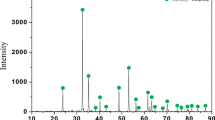Abstract
Copper concentrates with high levels of toxic impurity elements such as As, Sb Bi, must be pretreated before processing in the current smelting/converting refineries. The classical method for the pretreatment of dirty copper concentrates is partial oxidizing roasting, where the impurities are eliminated through the gas phase. However, volatilization of antimony and bismuth in conventional roasting processes using air or oxygen-deficient air is hardly achieved since antimony and bismuth remain in the calcine as non-volatile oxides. The chloridizing of stibnite with calcium chloride was studied as an alternative to volatilize antimony from impure copper concentrates because the vapor pressure of antimony chloride is higher than the vapor pressures of antimony oxide or sulfide at low temperatures. Thus, in the present work, the kinetic study of chloridizing of antimony from stibnite using calcium chloride as the chloridizing agent was studied at roasting temperatures 500 °C to 650 °C. The salient aspects determined in this study are that the chloridizing of stibnite starts with the formation of Sb2O3 followed by the chloridizing of this oxide by chlorine gas. The formation of antimony oxide Sb6O13 deters the complete elimination of antimony from stibnite. By using the unreacted shrinking core model 1 − (1 − α)1/3 = krt, the chloridizing rate of stibnite with CaCl2 and oxygen was found to be of 0.6 order with respect to the oxygen partial pressure, and the calculated energy of activation is 62 kJ mol−1 in the range from 500 °C to 650 °C.

















Similar content being viewed by others
References
K. Baxter, H. Scriba, and I. Vega: Copper 2010 Conf. Proc. Germany, 2000, pp. 1783–1802.
A. Holmström: Scand. J. Metallurgy, 1988, vol. 17, pp. 259-271.
A. Holmström: Scand. J. Metallurgy, 1988, vol. 17, pp. 272-280.
R. Padilla, A. Aracena, and M.C. Ruiz: Metall. Matter. Trans. B, 2012, vol. 43B, pp. 1119-1126.
R. Padilla, G. Ramirez, and M.C. Ruiz: Metall. Matter. Trans. B, 2010, vol. 41B, pp. 1284-1292.
R. Padilla, I. Moscoso, and M.C. Ruiz: Applications of Process Engineering Principles in Materials Processing, Energy and Environmental Technologies, S Wang et al. eds., TMS, Springer, 2017, pp. 319-326.
A. Roine: HSC Chemistry 9.4.1. Outokumpu Research Oy, 2017, Pori, Finland.
J.K. Gerlach, F.E. Pawlek: Trans. Metall. Soc. AIME, 1967, vol. 239, pp. 1557-1564.
E. Peek: Chloride Metallurgy: in Process Technology Development, EPD Congress 2011, S.N. Monteiro et al., eds., TMS, Warrendale, PA, 2011, pp. 477–501.
H.Y. Sohn: Metall. Trans. B, 1978, vol. 9B, pp. 89-96.
H.Y. Sohn: Chemical Engineering Science, 2004, vol. 59, pp. 4361-4368.
J. Szekely, J.W. Evans, and H.Y. Sohn: Gas-Solid Reactions, Academic Press, New York, NY, 1976.
Acknowledgment
The authors acknowledge the National Fund for Scientific and Technological Development (FONDECYT) of Chile for the financial support of this research through Project No. 1150339.
Author information
Authors and Affiliations
Corresponding author
Additional information
Manuscript submitted February 17, 2018.
Rights and permissions
About this article
Cite this article
Padilla, R., Moscoso, I. & Ruiz, M.C. Mechanism and Kinetics of Stibnite Chloridizing with Calcium Chloride-Oxygen at 500 °C to 650 °C. Metall Mater Trans B 50, 219–228 (2019). https://doi.org/10.1007/s11663-018-1445-y
Received:
Published:
Issue Date:
DOI: https://doi.org/10.1007/s11663-018-1445-y




